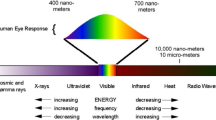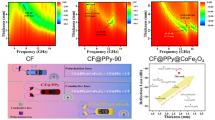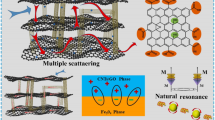Abstract
A theoretical model for microwave absorption from both forced non-resonance oscillation and resonance is constructed using the transmission line theory familiar to microwave engineers. The model covers both the single-phase ferrite and its composites of interest to material scientists, and can be applied to a variety of different absorption mechanisms. The transmission line theory is also shown to be consistent with the band theory of solids, a relationship that has not been revealed previously. The work bridges the gap between the interests of microwave engineers and material scientists.







Similar content being viewed by others
References
Pullar, R.C.: Hexagonal ferrites: a review of the synthesis, properties and applications of hexaferrite ceramics. Prog. Mater. Sci. 57, 1191–1334 (2012)
Li, S., Akyel, C., Bosisio, R.G.: Precise calculations and measurements on the complex dielectric constant of lossy materials using TM010 cavityperturbation techniques. IEEE Trans. Microw. Theory Tech. MTT-29(10), 1041–1048 (1981)
Liu, Y., Tai, R., Drew, M.G.B., Liu, Y.: Preparation and characterizations of active carbon/barium ferrite/polypyrrole composites. J. Mater. Sci. Mater. Electron. (2017). doi:10.1007/s10854-017-6330-y
Liu, Y., Jin, J., Drew, M.G.B., Liu, Y.: Several theoretical perspectives of ferrite based materials—part 2: close packing model for crystal structure. J. Supercond. Nov. Magn. (2017). doi: doi:10.1007/s10948-017-4042-4
Liu, Y., Liu, Y., Yin., H., Drew, M.G.B.: Several theoretical perspectives of ferrite based materials—part 3: crystal structure and synthesis. J. Supercond. Nov. Magn. (2017). doi:10.1007/s10948-017-4040-6
Harris, V.G., Geiler, A., Chen, Y., Yoon, S.D., Wu, M., Yang, A., Chen, Z., He, P., Parimi, P.V., Zuo, X., Patton, C.E., Abe, M., Acher, O., Vittoria, C.: Recent advances in processing and applications of microwave ferrites. J. Magn. Magn. Mater. 321, 2035–2047 (2009)
Sadiq, I., Naseem, S., Rana, M.U., Ashiq, M.N., Ali, I.: Temperature dependent magnetic and microwave absorption properties of doubly substituted nanosized material. J. Magn. Magn. Mater. 385, 236–242 (2015)
Jamalian, M., Ghasemi, A., Paimozd, E.: A comparison of the magnetic and microwave absorption properties of Mn-Sn-Ti substituted strontium ferrite with and without multiwalled carbon nanotube. Curr. Appl. Phys. 14, 909–915 (2014)
Li, L., Xiang, C., Qian, H., Hao, B., Chen, K., Qiao, R.: J. Mater. Res. 26, 2683–2690 (2011)
Hong, Y-K., Lee, J.: Ferrites for RF passive devices. Solid State Phys. 64, 237–329 (2013)
Ozgur, U., Alivov, Y., Morkoc, H.: Microwave ferrites, part 1: fundamental properties. J. Mater. Sci.: Mater. Electron. 20, 789–834 (2009)
Ozgur, U., Alivov, Y., Morkoc, H.: Microwave ferrites, part 2: passive components and electrical Tuning. J. Mater. Sci.: Mater. Electron. 20, 911–952 (2009)
Baker-Jawis, J., Janezic, M. L. D., Grosvenor, J. H. Jr., Geyer, R. G.: Transmission/reflection and short-circuit line methods for measuring permittivity and permeability. Natl. Inst. Stand. Technol. Tech. Note 1355-R (1993)
Vepsalainen, A., Chalapat, K., Paraoanu, G.S.: Measuring the microwave magnetic permeability of small samples using the short-circuit transmission line method. IEEE Trans. Instrum. Meas. 62(9), 2503–2510 (2013)
Gairola, S.P., Verma, V., Singh, A., Purohit, L.P., Kotnal, R.K.: Modified composition of barium ferrite to act as a microwave absorber in X-band frequencies. Solid State Commun. 150, 147–151 (2010)
Gupta, C.D.: Microwave measurement of a complex dielectric constant over a wide range of values by means of a waveguide-resonator method. IEEE Trans. Microw. Theory Tech. MTT-22(4), 365–372 (1974)
Ligthart, L.P.: A fast computational technique for accurate permittivity determination using transmission line methods. IEEE Trans. Microw. Theory Tech. MTT-31(3), 249–254 (1983)
Vepsalainen, A., Chalapat, K., Paraoanu, G.S.: Measuring the microwave magnetic permeability of small samples using the short-circuit transmission line method. IEEE Trans. Instrum. Meas. 62(9), 2503–2510 (2013)
Hu, X.-P.: Using six-port reflectometer measurement of complex dielectric constant. IEEE Trans. Instrum. Meas. IM-36(2), 537–539 (1987)
Kasten, J.S., Steer, M.B., Pomerleau, R.: Enhanced through-reflect-line characterization of two-port measuring systems using free-space capacitance calculation. IEEE Trans. Microw. Theory Tech. 3.8(2), 215–217 (1990)
Rouss, G., Agbossou, K., Thiebaut, J.-M.: Improved modeling of permittivity measurement cells. IEEE Trans. Instrum. Meas. 41(3), 366–369 (1992)
Nassar, E.M., Lee, R., Young, J.D.: A probe antenna for in situ measurement of the complex dielectric constant of materials. IEEE Trans. Antennas Propag. 47(6), 1085–1093 (1999)
Weir, W.B.: Automatic measurement of complex dielectric constant and permeability at microwave frequencies. Proc. IEEE 62(1), 33–36 (1974)
Meshram, M. R., Agrawal, N. K., Sinha, B., Misra, P. S.: Characterization of M-type barium hexagonal ferrite-based wide band microwave absorber. J. Magn. Magn. Mater. 271, 207–214 (2004)
Luo, J., Xu, Y., Gao, D.: Synthesis, characterization and microwave absorption properties of polyaniline/Sm-doped strontium ferrite nanocomposite. Solid State Sci. 37, 40–46 (2014)
Blakney, T.L., Weir, W.B.: Comments on “Automatic measurement of complex dielectric constant and permeability at microwave frequencies”. Proc. IEEE 63(1), 203–205 (2005). doi:10.1109/PROC.1975.9725
Chen, M., Chen, C.-C.: Improved permittivity calibration method for wideband in situ permittivity probe. IEEE Geosci. Remote Sens. Lett. 10(2), 323–327 (2013). doi:10.1109/LGRS.2012.2205366
Suzuki, H., Hotchi, T., Nojima, T.: A new measurement system for the perpendicular complex permittivity to DUT sheet by stripline simulation. IEEE Trans. Instrum. Meas. 61(9), 2476–2482 (2012)
Nicolson, A.M., Ross, G.F.: Measurement of the intrinsic properties of materials by time-domain techniques. IEEE Trans. Instrum. Meas. IM-19(4), 377–382 (1970)
Baker-Jawis, J., Vanzura, E.J., Kissick, W.A.: Improved technique for determining complex permittivity with the transmission /reflection method. IEEE Trans. Microw. Theory Tech. 38(8), 1096–1103 (1990)
Vanzura, E.J., Baker-Jarvis, J.R., Grosvenor, J.H., Janezic, M.L.D.: , Intercomparison of permittivity measurements using the transmissiofleflection method in 7-mm coaxial transmission lines. IEEE Trans. Microw. Theory Tech. 42(11), 2063–2070 (1994)
Blackham, D.V., Pollard, R.D.: An improved technique for perimittivity measurements using a coaxial probe. IEEE Trans. Instrum. Meas. 46(5), 1093–1099 (1997)
Pozar, D.M.: Microwave Engineering, 2nd edn. Wiley, New York (1998)
Collier, R.J., Skinner, A.D.: Microwave Measurements, 3rd edn. Athenaeum Press, London (2007)
Kraus, J.D., Fleisch, D.A., Russ, S.H.: Electromagnetics with Applications, 5th edn, pp 62–211. Tsinghua University Press, Beijing (2001)
Liu, Y., Drew, M.G.B., Liu, Y., Liu, Y., Cao, F.L.: A comparative study of Fe3O4/polyaniline composites with octahedral and microspherical inorganic kernels. J. Mater. Sci. 49, 3694–3704 (2014)
Liu, Y., Li, X., Drew, M.G.B., Liu, Y.: Increasing microwave absorption efficiency in ferrite based materials by doping with lead and forming composites. Mater. Chem. Phys. 162, 677–685 (2015)
Kurokawa, K.: An Introduction to the Theory of Microwave Circuits. Academic Press, New York (1989)
Guru, B.S., Hiziroglu, H.R.: Electromagnetic Field Theory Fundamentals. China Machine Press, Beijing (2002)
Gonzalez, G.: Microwave Transistor Amplifiers, Analysis and Design, 2nd edn. Prentice Hall, New Jersey (1984)
Grosso, G., Parravicini, G.P.: Solid State Physics. Academic Press, Amsterdam (1999)
Liu, Y., Liu, Y., Drew, M.G.B.: Correlation between Fourier series expansion and Hückel orbital theory. J. Math. Chem. 51, 503–531 (2013)
Patterson, J.D., Bailey, B.C.: Solid-State Physics, Introduction to the Theory, pp 148–157. Springer, Berlin (2007)
Liu, Y., Drew, M.G.B., Liu, Y.: Intermediate ion stability and regio selectivity polymerization using neutral salicyladiminato in propene nickel(II) and palladium(II) complexes as catalysts. J. Mol. Struct. (Theochem) 809(1–3), 29–37 (2007)
Liu, Y., Liu, Y., Drew, M.G.B.: Aspects of quantum mechanics clarified by lateral thinking. Chem. Educator 16, 272–274 (2011) http://chemeducator.org/bibs/0016001/16110272.htm
Acknowledgments
This work was supported by the Education Ministry of Liaoning Province (L2015497) and the Natural Science Foundation of Liaoning Province (2015020233).
Author information
Authors and Affiliations
Corresponding author
Appendices
Appendix: Applications of Bloch’s Theorem
A.1 One Band
A wave function in a crystal must obey Bloch’s theorem (136).
u(r) in (136) is a periodic function regarding symmetry operations in a crystal. Vector r specifies the position of the electron in the orbital. The direction of vector k defines a translation in the crystal and its value related to energy of the orbital is often written in the form 2 π/ λ where λ is the wavelength. This k also appears in (133) for a one-dimensional crystal. Bloch’s theorem (136) is related to phase shift represented by (121), which means that a translation symmetry operation on a well-behaved function in a crystal generates a phase shift for the function.
If every atom in a one-dimensional crystal separated by a distance of |a| contributes an atomic orbital φ to a well-behaved crystal wave function ψ, then (137) is a crystal wave function that satisfies Bloch’s theorem and this is proved from (138)–(139).
N is the number of atoms in a complex unit cell. Vector r originates from one of the atoms. It represents the position of an electron and the origin is translated from one atom to another in (137) [42]. (137) can be rewritten in the form of (136).
u(r) in (138) is a periodic function proved by (139) involving any translation operation m a.
Equation (139) is valid because when n is summed over all the N atoms in the complex cell, \(n^{\prime } \) can similarly be summed in an equivalent cell. If
Then, the energy of the crystal orbital will be
When |k| takes the value from 0 to π/|a|, an energy band from (α + 2β) to (α − 2β) is created.
A.2 Two Bands
The theorem for two bands can be easily explained by reference to trans-polythene (Fig. 8). If each of the atoms from trans-polythene [44] contributes one atomic orbital (φ 1 or φ 2) to a crystal orbital, then the crystal-adapted orbitals (ϕ1,ϕ2) for the two sets of atoms shown by Fig. 1 can be written in a form similar to (137).
The origin for r is at the middle of a double bond. A crystal-adapted orbital is an orbital conforming to Bloch’s theorem. Crystal orbitals ψ are obtained from crystal-adapted orbitals [45].
The energy of the crystal orbitals can be obtained by inserting (144) into (145).
The evaluation can be simplified by the following assumptions with the same principle from (140).
The parameters β and \(\beta ^{\prime } \) are specific for the double and single bonds in the polythene, respectively. By inserting (147)–(151) into (146), the energy for the crystal orbital is obtained as shown by (153).
Two energy bands are obtained by varying k from 0 to π/|a|. If all the C–C bond lengths in the polythene are the same, then \(\beta = \beta ^{\prime }\) and there will be no energy gap between the bands, thus, the polymer is a conductor. However, if the double and single bonds are distinct with different bond lengths then the upper energy boundary of the lower band will be lowered from α to (\(\alpha - | {\beta } -{\beta }^{\prime }|\)) while the lower energy boundary for the upper band will be raised from the α to (\(\alpha + ~| {\beta } - {\beta }^{\prime } |\)). Thus, there is an energy gap of \(2|\beta - \beta ^{\prime }|\) between the two bands at k = π/|a| and the polymer is a semiconductor. Note the upper band is vacant while the lower band is filled with electrons for this neutral polymer.
Rights and permissions
About this article
Cite this article
Liu, Y., Tai, R., Drew, M.G.B. et al. Several Theoretical Perspectives of Ferrite-Based Materials—Part 1: Transmission Line Theory and Microwave Absorption. J Supercond Nov Magn 30, 2489–2504 (2017). https://doi.org/10.1007/s10948-017-4043-3
Received:
Accepted:
Published:
Issue Date:
DOI: https://doi.org/10.1007/s10948-017-4043-3





